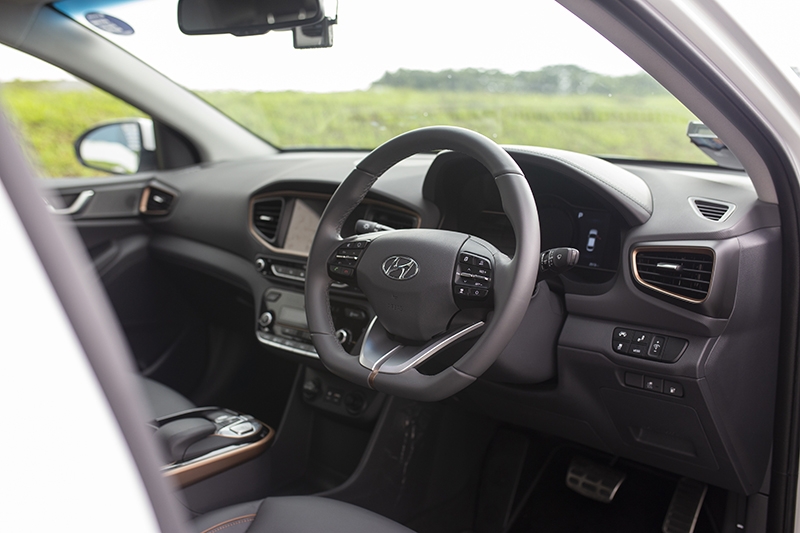Electrification comes in a slightly more conventional Korean package

In place of the Ioniq Hybrid’s 1.6-litre petrol engine and electric motor combination, you’ll find a single 88kW electric motor residing in the Ioniq Electric’s engine bay. This means 118 bhp and 295 Nm of instantaneous torque, and with a 28 kWh battery, this translates into a 280 km range that should be sufficient for a good three to four days of commuting.

When the time comes to plug the car in, it’ll cost you just $7.23 for a full charge (based on a $0.2582/kWh electricity tariff) — or about 2.6 cents per kilometre travelled.

If you’re the type that prefers not to shout about your efforts at saving the environment, the Ioniq Electric has got you covered. To the untrained eye, it looks identical to any regular sedan — with the exception of the single-piece front fascia, some copper-coloured highlights on the bumpers and doors, and the discreet ‘electric’ badge on the tailgate.

Contrastingly, the Ioniq Electric prefers to remind the driver of its eco-credentials instead. Inside the cabin, similar copper-coloured highlights extend to the dashboard, centre console and seats, as a subtle nod to copper’s excellent electric conductivity. Additionally, where you’d typically find a gear lever in regular cars now sits four buttons for gear selection.

Apart from those quirks, it feels normal and decently put together in typical Hyundai fashion. Some hard plastic surfaces could do with higher quality soft-touch plastics, but for the most part, important surfaces that you’d typically interact with — such as the steering wheel, gear buttons and air-con controls — have a pleasant feel to them.

Setting off for a drive in the Ioniq is a matter of simply jabbing three buttons — the power button, the parking brake button, and the gear selector button marked ‘D’ — before it wafts away silently. On the move, a hint of road noise comes through to the well-insulated cabin, but it’s so minimal that setting the radio to a normal volume is sufficient to mask it.

The Ioniq offers three driving modes and three levels of regenerative braking. Normal and Eco driving modes are what you should ideally leave it in for daily driving, while Sport sharpens the throttle response for instant acceleration when you want it. Two paddle shifters on both sides of the steering wheel toggle regenerative braking levels much like gear change paddles on a petrol car — pull the left one to make regenerative braking weaker, and vice versa for the right paddle.

Yes, it’s a tree-hugging car, but you still can have fun with it. The shift paddles and regenerative braking levels worked surprisingly well when hustling the car around a series of corners in Sport mode — the combination of instant torque and a linear power delivery, together with the paddles allowing me to ‘downshift’, resulted in the most hilarious bit of fast driving I’ve ever done.

As a complete package, the Ioniq Electric is a bit of a no-brainer — cheap to run, fun to drive, well equipped and with sufficient space for the entire family. The charging infrastructure hurdle for apartment-dwellers will soon be addressed too, with the large-scale charging network that’s set to be fully rolled out by the end of next year.

At S$134,999 as of January 2019, the cost of EV adoption might be prohibitive at first. But if you travel long distances regularly, the cost savings will eventually add up. Besides, the electric revolution is upon us — and the Ioniq Hybrid is a great stepping-stone into the future of motoring.

